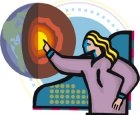
Worksheets and No Prep Teaching Resources
Reading Comprehension Worksheets
Earth Science

Earth Science
 Worksheets and No Prep Teaching Resources Reading Comprehension Worksheets Earth Science |
 Earth Science |
| edHelper's suggested reading level: | grades 9 to 10 | |
| Flesch-Kincaid grade level: | 9.88 |
| Print The Rock on the Bottom (font options, pick words for additional puzzles, and more) |
| Quickly print reading comprehension |
| Print a proofreading activity |
|
The Rock on the Bottom
By Trista L. Pollard |

|
| As I laid on a rock, I received such a shock, Another rock upon me lay, Dried and hardened throughout the day, Before I knew it, many more had lain upon me, Many strata as far as the eye can see... |
 |
Create Weekly Reading Books
Prepare for an entire week at once! |
| Leave your feedback on The Rock on the Bottom (use this link if you found an error in the story) |
 |
Earth Science
|
 |
High School Reading Comprehensions and High School Reading Lessons
|